Statues in Rome - 10 Most Famous
The city of Rome, Italian republic is filled with artwork of all kinds equally it has been a central location for artists since the days of the Roman empire many centuries ago. Rome was heavily influenced by its Greek neighbors and many of the most notable Italian artists that have existed in the final millennium take strong ties to Greece.
Sculpture has remained ane of the most prominent means of expression used past Roman artists to commemorate certain leaders, every bit well as gods or goddesses.
Various museums and other locations in Rome are loaded with a number of sculptures dating back to the Greek Classical era, as well as those from the Italian Renaissance. Some of the well-nigh celebrated sculptors in history have been of Italian descent and take produced works that are displayed in Rome or the surrounding cities.
Hither are our selections for ten of the almost famous statues in Rome.
Famous Statues in Rome
1. Pietà – Michelangelo
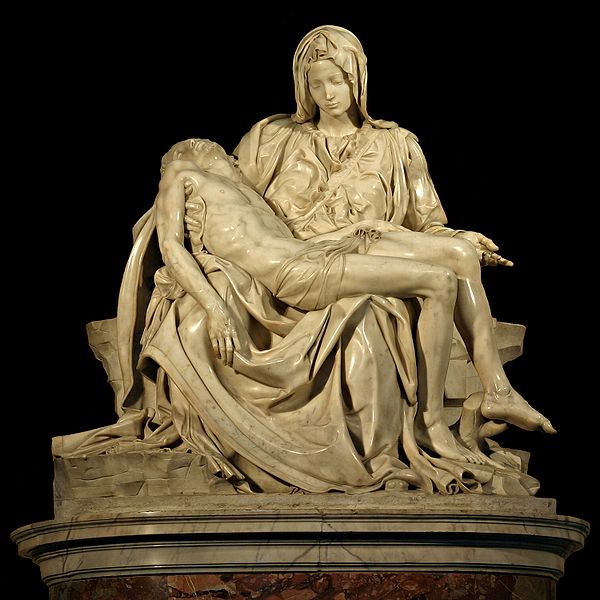
Michelangelo di Lodovico Buonarroti Simoni was ane of the Italian Renaissance's greatest artists who is more ordinarily known every bit Michelangelo. He was a gifted painter, but nigh critics and art historians view him equally one of the greatest sculptors of all time.
He produced a number of masterpieces that adorn the halls of Rome's cathedrals, likewise as those in other major cities throughout Italian republic.
One of his most celebrated sculptures is simply known as Pietà. Completed in 1499, this incredible statue depicts a scene in which Mary, the mother of Jesus, holds her son's lifeless body in her arms.
The piece of work was originally intended to be a funeral monument for the French ambassador to Rome, Primal Jean de Bilhères. However, one time it was completed, the sculpture was deemed to be too magnificent to exist displayed as simply a funeral slice and was instead placed in St. Peter'southward Basilica in The holy see.
The sculpture is possibly virtually famous for the intricate detail that Michelangelo was able to depict. Everything from the easily of Jesus to the face up of Mary and especially the clothing and robes she is wearing are all done with incredible, lifelike precision.
2. The Capitoline Wolf
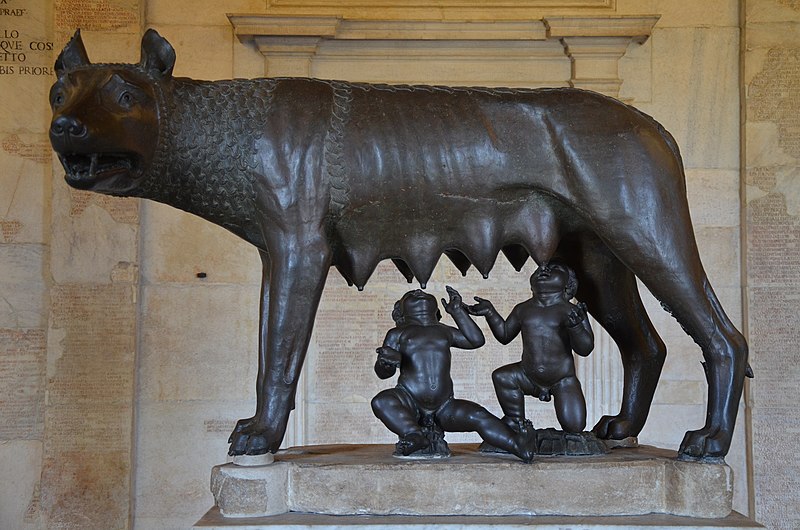
One of the most iconic statues in Rome is the Capitoline Wolf, which was created to commemorate the fable surrounding the founding of the urban center of Rome.
The exact appointment of this unique sculpture is unknown, merely stories from diverse parts of Rome's history merits that the statue was created during the 5th century B.C. by the Etruscans. According to recent radiocarbon dating techniques, the statue was dated to be as old as the 11th or twelfth century A.D.
The Capitoline Wolf legend states that two twin brothers, Romulus and Remus, were bandage into the Tiber River when their great uncle Amulius usurped the throne of their grandfather, King Numitor. The story states that the two children were rescued by a she-wolf who nursed them and kept them alive until they were institute by a shepherd.
The bronze statue is somewhat smaller compared to most other works in Rome that are as prominent. The she-wolf is standing as the 2 children suckle beneath her. She is baring her teeth as if to be protecting them from some type of threat.
3. Belvedere Body
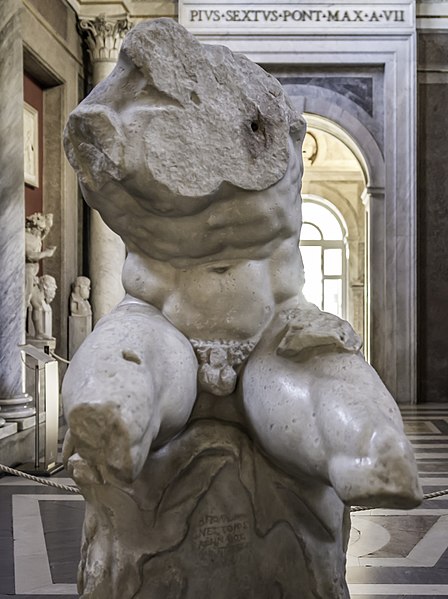
1 of the near famous statues in Rome is too 1 of the most mysterious works one might detect in the city. The sculpture known as the Belvedere Torso is a massive marble statue that stands at more than i.5 meters in height.
The exact appointment of completion is unknown, but many art critics and scholars once believed information technology could have been as old as the 1st century B.C.
Many once believed the statue to be a delineation of Hercules, a popular hero of Greek and Roman lore that was known for his incredible feats of strength.
The Belvedere Torso is really signed on the front of the base with some indication of its identity. The signature states: "Apollonios, son of Nestor, Athenian."
Although information technology's just a piece of a statue that was much larger at one time, this work was one time displayed in the Vatican during the 1500's. Information technology was said the Michelangelo greatly admired the sculpture and ofttimes visited the Vatican to view it during his career.
four. Moses – Michelangelo

Many of the about famous statues from the city of Rome are centered effectually figures from the Christian Bible and the Catholic faith. Michelangelo, who was perhaps the about well-known sculptor to have ever lived during the Italian Renaissance, is credited with producing 1 of the about highly-regarded sculptures of a Biblical figure from the time period.
The sculpture is titled Moses and depicts the widely-known Bible hero seated with a very serious expression while property 2 stone tablets. This is a portrayal of a scene from the Bible in which Moses is said to take climbed Mount Sinai and God delivered to him the Ten Commandments on two large rock tablets.
The disguised grade of Moses was done with infrequent detail and the marble statue is considered to exist one of Michelangelo'due south greatest works since information technology was completed in 1515.
5. Augustus of Prima Porta
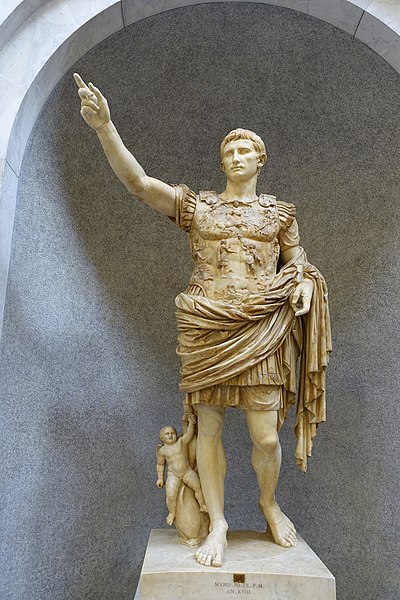
Numerous statues in Rome were dedicated to some of the greatest figures from the peak of the Roman Empire. Ane such work is titled Augustus of Prima Porta and was created one-time in the 1st century A.D. to commemorate one of the more well-known leaders of the Roman Empire, Augustus Caesar.
This larger-than-life depiction of the powerful figure stands at more than than 2 meters tall and weighs more than ane,000 kilograms.
It was nearly lost to history until it was discovered in 1863 during an archaeological excavation of Villa of Livia, which was the home of Augustus Caesar'south wife, Livia Drusilla.
This work boasts incredible detail and historians are even so unaware of who created the masterful statue. Information technology is believed to be a copy of an older bronze statue that was probable carved by Greek sculptors as there were few in Rome at this time who were capable of producing such a detailed sculpture.
vi. The Statue of Saint Peter , Saint Peter's Basilica
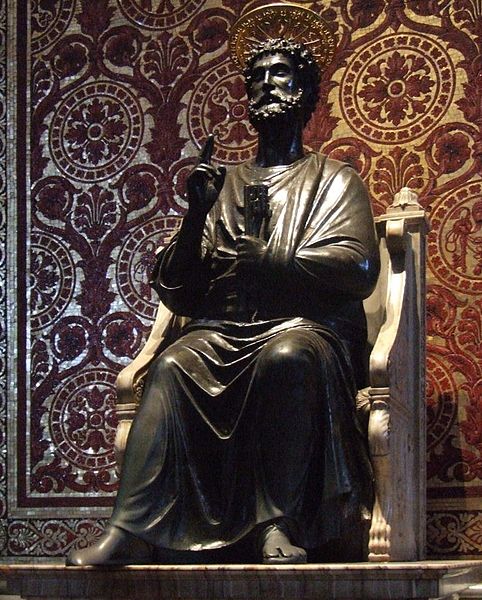
Saint Peter is 1 of the most prominent figures from the New Testament and he is viewed equally the founding fellow member of the Cosmic church. Many artists during the Italian Renaissance produced various works depicting the campaigner and his various exploits during the lifetime of Jesus Christ and afterward.
One of the almost prominent works that portrays the famous saint is known simply as The Statue of Saint Peter. This statue sits in Saint Peter's Basilica, which is as well home to such works as Michelangelo'southward Pieta, the Monument of Pope Alexander and the supposed grave of Saint Peter himself.
The black statue is made out of bronze and is seated on an elaborate marble chair. The statue is credited to Arnolfo di Cambio, a famous artist from Tuscany who likely created the bronze in the 1200's. Many of the Catholic faith travel to the site to kiss the feet of the statue.
7. Habakkuk and the Angel – Bernini
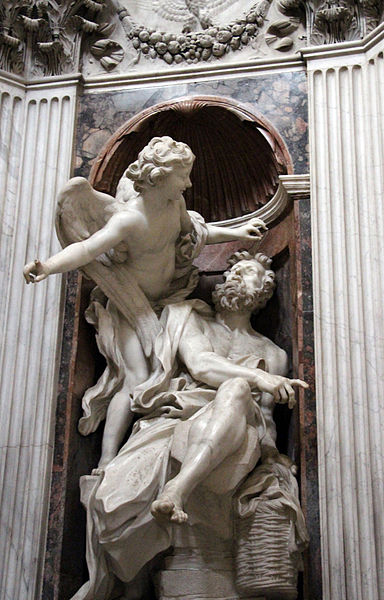
One of the most elaborate statues that still stands in Rome today is known as Habakkuk and the Angel. This famous work was done by Gian Lorenzo Bernini, a renowned sculptor and architect who lived during the 17th century and created a number of incredible works that can exist seen throughout the metropolis.
Created in 1661, the statue is a depiction of the well-known Biblical story in which Habakkuk, a Judean prophet, made stew that he intended to give to reapers working in a nearby field.
An angel appeared and instructed Habakkuk to take the stew to Daniel, who was imprisoned in a panthera leo'due south den.
Habakkuk was somewhat resistant to the angel who and then led the prophet by the crown of his head to the city of Babylon where Daniel was being held. The big marble work sits in the Basilica of Santa Maria del Popolo in Rome.
8. Fontana dei 4 Fiumi
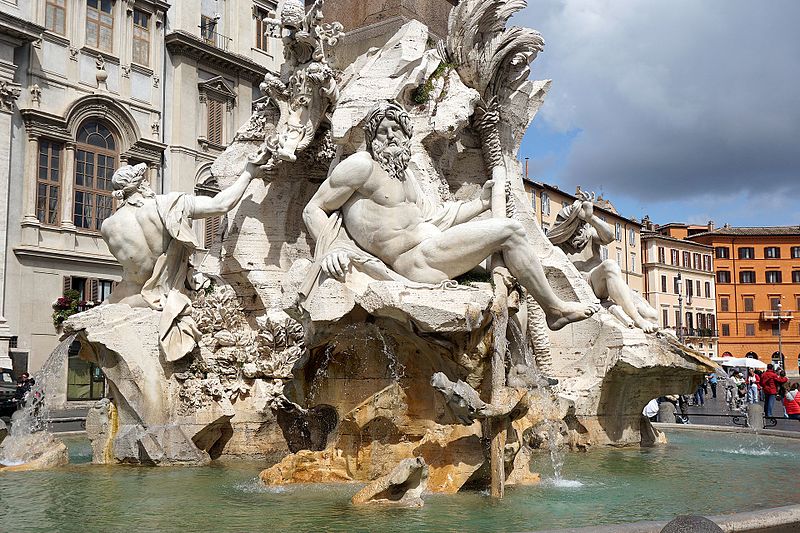
Ane of the most famous fountains in Rome that's likewise a prominent landmark is the Fontana dei 4 Fiumi. This elaborate work sits at the Piazza Navona in Rome and was made as a statue that would honor the four river gods and the four major river systems that are located in the iv continents through which the Catholic church had spread its influence over.
It was designed past Gian Lorenzo Bernini and commissioned in 1651 by Pope Innocent X. The four rivers that are represented are the Rio de la Plata in South America, the Danube in Europe, the Ganges in Asia and the Nile River in Africa.
A massive Egyptian style obelisk stands in the middle of the structure with the image of a dove holding an olive twig on the very top.
This dove and olive twig was indicative of the story of Noah'due south Ark and was also the emblem of the Pamphili family, who had a large palace facing the monument that still stands today.
9. Daniel and the King of beasts – Bernini
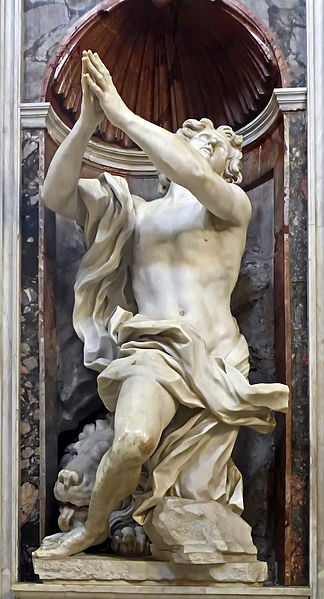
Gian Lorenzo Bernini's fascination with the story of Daniel and the lion'south den was the driving strength backside the statue he created depicting Habakkuk, as well as some other famous statue that still stands in Rome.
This work is titled Daniel and the Lion and was created in 1657 for the then cardinal-priest of the Basilica of Santa Maria del Popolo.
The cardinal-priest, Fabio Chigi, was subsequently elected pope under the name Alexander VII. Like most of Bernini's other sculptures, this work depicts the man form in motion as Daniel is stretching upwards while praying to God. The prophet Daniel is kneeling on a pedestal while a lion is seen behind him licking his heel.
ten. Dying Gaul
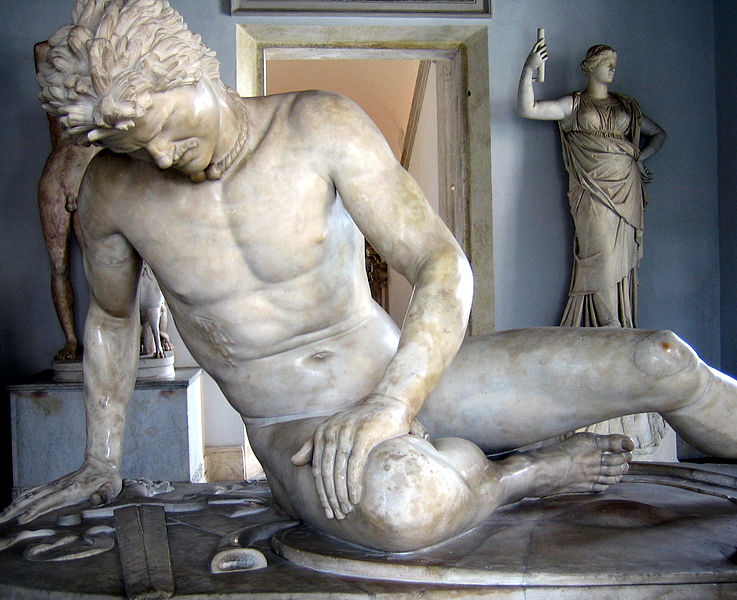
The Roman Empire was surrounded by enemies in 2d and 3rd centuries B.C. as their power stretched throughout much of the region along the Mediterranean Ocean.
The forces of the Roman Empire fought intense battles with the native people of western Europe who were known as the Celts or the Gauls. 1 statue commemorating these warriors and the battles the Roman Empire fought with them is titled the Dying Gaul, or Dying Galatian.
This statue is believed to have been made some time between 200 and 350 B.C. and is virtually likely a copy of an before work that has since been lost to history. The life-sized statue was carved out of white marble and depicts an incredibly realistic nude Gaul soldier sitting on the ground, suffering from a sword wound in his lower breast.
The work is believed to be highly realistic as the Gauls were said to fight naked and frequently had characteristic hairstyles and mustaches like to the one depicted that were a symbol of condition and virility. The soldier is seen sitting on his shield with his sword lying below him.
Source: https://www.artst.org/statues-in-rome/
0 Response to "Statues in Rome - 10 Most Famous"
Post a Comment